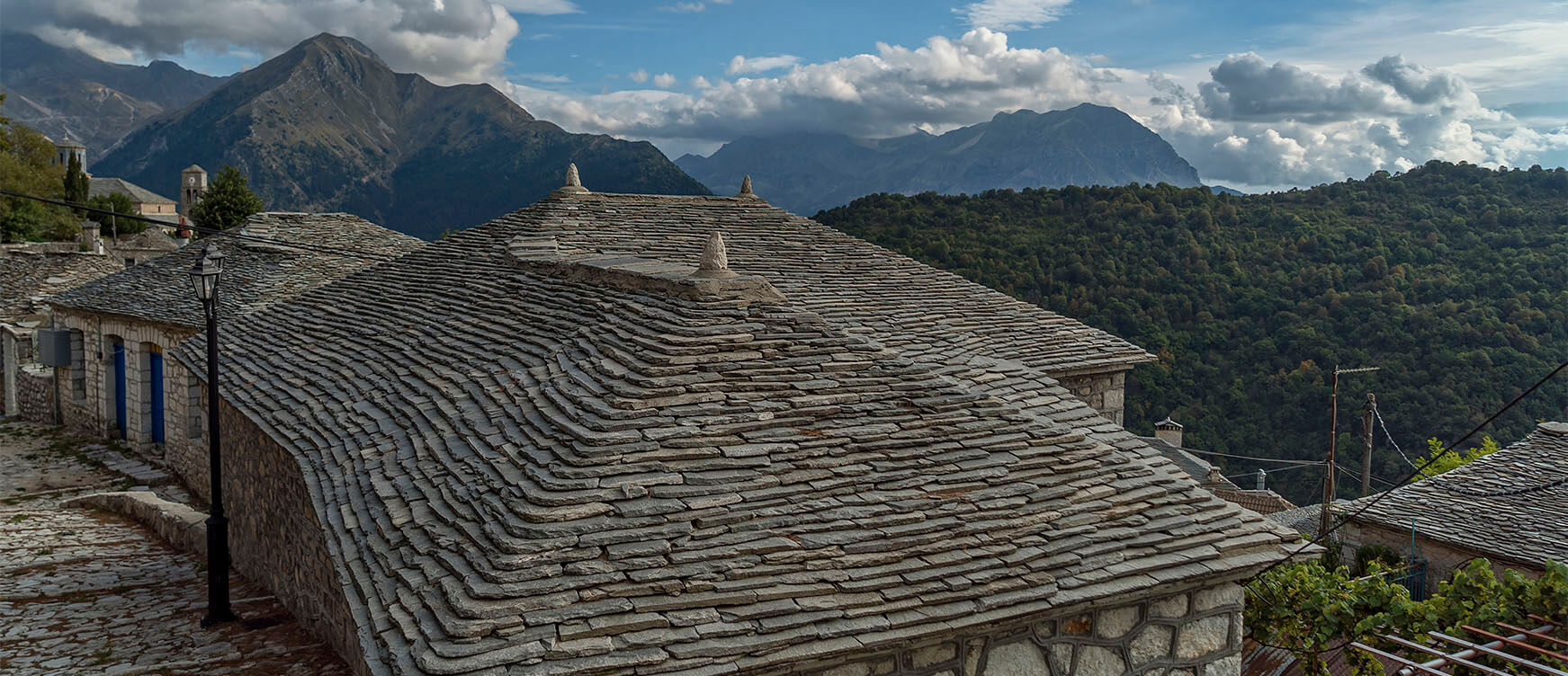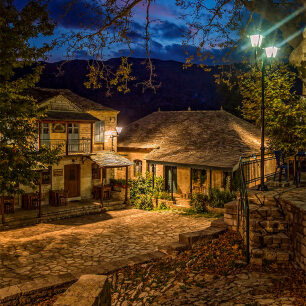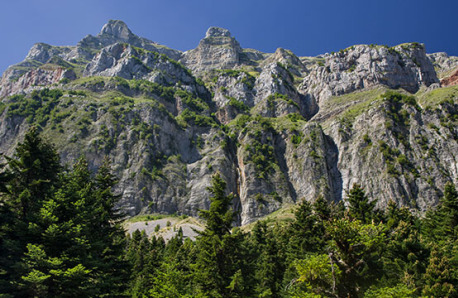
Tzoumerka
NOW
2 °C
Next 5 days
-
SUN
9 °C
-
MON
10 °C
-
TUES
6 °C
-
WED
4 °C
-
THURS
2 °C
-
FRI
4 °C
Climatic Data
Source: National Observatory of Athens /meteo.gr
Unique Experiences
Discover Tzoumerka Villages
Built in the slope of mount Lakmos, Syrrako is a traditional village, a true gem of the local architecture with its hooked from the rocks stone houses and its slate roofs. Syrrako is located opposite Kalarrites, separated by a deep gorge, which seems to roar from the rushing waters of Chroussia, a tributary of the Arachthos River.
It was constructed around the 15th century by Vlach-speaking populations. Its glorious past and the economic prosperity it experienced in previous centuries - thanks to the famous tailors, merchants, and breeders from Syrrako, who honoured their homeland in the great markets of the Mediterranean in the 18th and 19th centuries - are revealed to us through a walk in its stone-paved streets. The architectural wealth and the celebration of stone in every corner, the mansions with arched entrances and paved roofs, the stone bridges, the carved stone fountains, the beautiful church of Agios Nikolaos with its gilded epitaphios, protector of the village, the central square, the busts, and the folklore treasure, all gathered in the Folklore Museum of Syrrako, are irrefutable witnesses to the thriving economy of the place. Among the statues you will see the bust of Ioannis Kolettis, who was a member of the Filiki Eteria and served as Prime Minister of the country from 1844-1847, and also that of the writer-politician Christos Zalokostas. In your walk, you will come across the house of Kostas Krystallis, adorned with the bust of the great poet, and it houses the village's library.
Enjoy endless walks on foot, as cars are not allowed inside the village. If you love hiking, a beautiful path starts from Syrrako and connects the village with Kalarrites. You can also drive towards Prosilio and pass through a spectacular landscape. Syrrako offers guesthouses, endless natural beauty and traditional taverns. On the central square, you will find them around the church, and you will have the chance to savour local delicacies along with tsipouro.
If you happen to be in the village on August 15, you will be able to visit the Syrrako Festival, which has been inscribed in UNESCO's Intangible Cultural Heritage list, along with Tranos Choros (Grand Dance) in Vlasti, Kozani. It’s a local cultural event that is not to be missed. The festival takes place in honour of the Dormition of the Mother of God (celebrated on August 15) and it is connected to the traditions of the pastoral community, who would gather there for the festivities, before the annual migration of their cattle to winter pastures. Despite the decline in the population of these mountain communities, the festival retains its importance as a means for reuniting locals and preserving their cultural heritage.
Kalarrites
The gorge of Kalarritis river separates Syrrako from the neighbouring village of Kalarrites. Although they are relatively close in a straight line (about 1 km apart), in reality, accessing one village from the other requires a challenging 23-kilometre drive through winding roads. That's why the best and most pleasant way to visit the neighbouring village is through the trail that connects them. Here, the authentic Epirotic architecture with stone-built houses, with arched entrances and stone roofs is the characteristic element of the village, which is built on a rocky slope of the mountain.
Kalarrites had a significant economic growth during the Ottoman period, especially with the flourishing of silversmithing under the protection of Ali Pasha. Renowned silversmiths from Kalarrites (including Sotiris Boulgaris, the founder of the famous BVLGARI jewellery house) developed a strong trade in the Mediterranean. As a result of this economic prosperity, literacy also flourished at a time when reading and writing was considered a privilege of very few in the rest of Greece.
During your walk, you will come across the church of Agios Nikolaos (15th century) with remarkable frescoes, while in the picturesque central square, which in the past was used as a court of public opinion, you will find small shops with local products, taverns and also a traditional antique shop. Enjoy the view to the Kalarritiko river, and visit some of the mansions of the area, such as the ones of Boulgaris, Mpazakis and many more. Cars are not allowed inside the village, but you can find four parking areas just outside the village in Gondro, Tsiora, Argi and Plaka.
A few kilometres outside Kalarrites, in about a 10-minute drive, visit the Monastery of Kipina (1212), dedicated to the Zoodochos Pigi, with impressive 17th-century frescoes. This monastery, embedded on a steep, vertical cliff, is one of the most impressive and imposing not only in Epirus, but also throughout Greece. The sight of it is awe-inspiring and breath-taking. It is worth climbing a few steps to visit it, and if the priest is not there, you can ask for the key before reaching the Monastery at the nearby village café. An interesting hiking route, if you enjoy trekking, starts from Kalarrites and leads to the Kipina Monastery, through a 70-metre-long bridge and tunnel.
Pramanta
Built amphitheatrically at the foot of Stroggoula peak (altitude 840 m), behind which extends the mountain range of Tzoumerka, Pramanta is one of the most famous Mastorochoria (villages of the masters) of Tzoumerka. It is a mountainous tourist resort, with a variety of hotels, restaurants, pastry shops, cafés and nightlife. It is worth visiting the village’s central square, with its centenary plane tree and the famous fountain of Arapi across the prestigious church of Agia Paraskevi and admire the original stone and iron statues honouring the region’s stone craftsmen.
At the entrance of the village, visit the spectacular Anemotripa Cave, where you can hear the running water of the crossing river before it creates a 2-meter tall waterfall. Inside the cave, there are three ponds in shades of grey, pink and white that have been formed under the wonderfully coloured stalagmites. You can also visit the monastery of Agia Paraskevi, on the way to Melissourgoi, the forest of Markopoulos, the fountain of Skala, the traditional watermill at Christoi as well as the mountain shelter at “Isioma”.
Melissourgoi
Melissourgoi is located at an altitude of 850 m, and is said to have been named after the bees (‘Melissa’ in Greek), as bees are a model of industriousness and represent the hard work of the villages’ inhabitants. The wild nature along with the clear waters and fir forests give this village a particular natural beauty. During your visit there, you will have the chance to get to know one of the most beautiful places in Tzoumerka with lush vegetation, many springs and landscapes of natural beauty, one of which is the Kefalovryso Waterfall, the tallest in the country, just a short distance from the village.
In the centre of the village, you will find the cobblestone square of Ethniki Antistasi with its springs and plane trees, where you will also find the village taverns for coffee, drinks and food. A little further up is the square of Kambos, while at the lower part of the village, you will find Panagia Square, with its natural grass and traditional tourist kiosk-café. The mountain refuge of Melissourgoi is also worth a visit, where excursions to nature are organised.
Katarraktis
It is a pretty village built at 800 m, right past Agnanta. Katarraktis (waterfall in Greek) got its name from the twin waterfalls found very close, a little higher up from the village that you cannot miss! It is also worth a visit to The Monastery of Agia Ekaterini.
Kalentzi
This is one of the most tranquil villages of the area, with a key location, ideal all year long either for relaxing vacation in nature, or for adventurous excursions in Tzoumerka. Its beautiful wild nature transforms this village into a different scene every season of the year. The springs of Klifki, whose rushing waters you can see cascading into Arachthos river by going rafting, can be reached by hiking from the village square and are of unique beauty.
Ktistades
Ktistades is another picturesque village of Tzoumerka that "looks up" at the top of Stroggoula and is built at an altitude of 720 m. It took its name from the many stone craftsmen who were active in the area.
Here, among cedars and firs, holly and oak trees, you will find chalets for your stay, only surrounded by the sounds of running waters, the songs of the nightingales and the bells of the sheep and with a unique view of the majestic mountain ranges, the blue sky, and the white snow during the winter.
Vourgareli
Vourgareli is a quiet village with raw natural beauty, lush green scenery, picturesque fountains and abundant fresh waters, as well as historical monuments. It is built at an altitude of 775 m, on the fringes of Tzoumerka, between two fir-covered hills.
It is an ideal destination all year round, only 30 min away from the natural pools of Acheloos river. Among the must-see attractions of the village are the unique Byzantine Red Church, the monastery of Agios Georgios, the waterfall in Giannitsi, as well as the traditional watermills in Palaiokatouno. Finally, for the hiking enthusiasts, we suggest the stunning path from Leptokarya to Neraidogefyro (“the fairies’ bridge”), and also the National Park of Tzoumerka, Peristeri and Arachthos Gorge which you can access through the entrance near the village.
Theodoriana
Built at an altitude of 950 m on the slopes of Eastern Tzoumerka, this village’s raw landscape full of intense contrasts will captivate you forever. Theodoriana, surrounded by two rushing rivers, bare and rugged mountain peaks and dozens of springs and bridges, is a natural paradise, ideal for excursions.
Among the most impressive attractions are the Souda Waterfalls, from the biggest ones in Greece, that fall from a height of 25 m before they join the stream of Aspri Goura.
Agnanta
This is one of the biggest villages of Tzoumerka, next to Katarraktis. Agnanta is well known for its dense vegetation and its numerous natural springs that provide locals and visitors with a sense of freshness.
Don’t miss the well-preserved traditional water mill still in use, as well as the folklore museum, where you can get acquainted with the traditional local lifestyle of the past.
Elliniko
In the west of Arachthos and at an altitude of 740 m, you will encounter a unique village, Elliniko, with dozens of sculptures scattered everywhere, from the entrance to the Monastery of Stouka, giving the feeling of an open-air gallery, an outdoor museum. These sculptures are work of the famous contemporary sculptor Theodoros Papagiannis, who donated his art to his hometown. In the village, you can also find the homonymous museum, which is housed in the school.
Kostitsi
Very close to Elliniko, you will find another Katsanochori of Epirus, called Kostitsi. It was first inhabited in the 17th century and until today it remains traditional to this day, with beautiful cobblestone streets, threshing floors, and unique stone houses built by skilled Tzoumerka craftsmen. Hike up to Prophet Elias church at 950 m and enjoy the unique view of the delta formed by Arachthos and Kalarritiko rivers.
Plesia
A small Katsanochori next to Kostitsi, built amphitheatrically and radially around the central square. There, where all the village's activities, social, economic, cultural, and religious, converge, we recommend stopping for a Greek coffee. The village spreads among walnut trees, fig trees, wild pear trees, quince trees, mulberry trees, and large plane trees, while the red-tiled roofs of the stone houses "decorate" the green of the surrounding trees.
Plaka
One more Katsanochori where you will have the chance to visit the historic bridge of Plaka. It is probably the largest one-arch stone bridge in the Balkans, with 61 m of length, 20 m of height and about 40 m of arch’s width. Arachthos river crosses under the bridge and offers various rafting routes while you can enjoy the natural beauty of the river’s valley. Here you can also find many companies that organise activities in the Tzoumerka area.










